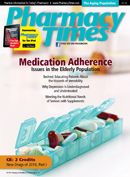Publication
Article
Pharmacy Times
Drug Diversion--The Past 20 Years, Part 2
Author(s):
Our drug diversion expert outlines the trends and implications of drug abuse for the past 20 years in part of his review of this national issue.
Our drug diversion expert outlines the trends and implications of drug abuse for the past 20 years in part of his review of this national issue.
This is part 2 of my column reminiscing about the past 20 years in the world of prescription drug abuse, commonly called drug diversion. By the way, the definition of drug diversion has recently been determined to be: “Any criminal act involving a prescription drug.” This comes from the executive board of the National Association of Drug Diversion Investigators, and I think although simple, it adequately defines the topic.
One of the things that changed most of our lives in some way is the Internet. The World Wide Web has made a big difference in the world of drug diversion too. It has allowed new types of crimes and more volume, and it has interjected our youth into this problem, while at the same time giving us computerized databases that greatly assist investigators in doing their jobs.
When I started supervising the investigation of drug diversion crimes in 1990, the population that was less than 18 years old rarely, if ever, came on our radar screen. The reason was simple—they were virtually unable to doctor shop, pass forged or altered prescriptions, or generate the many scams that were already commonplace for adults. Although this age group was certainly experimenting with drugs, prescription medications generally were not among them.
An Explosion of Addiction
Unfortunately, this has all changed and the Internet is probably the biggest reason. Rapid exchange of information among teenage abusers of all sorts, and the unending ability to mine virtually any information on any drug of abuse, including prescriptions, has created an explosion of this type of dependence and addiction.
The knowledge that our youth gained concerning prescription drugs also led them to an easy supply—their family’s medicine cabinet. The supplies found here have led to the reality that the leading drugs of abuse for 12- and 13-yearolds now are pharmaceuticals, while older teens continue to abuse these same drugs, second only to marijuana.
The Internet has also created an entirely new source of illegal prescription drugs through the creation of hundreds, if not thousands, of Web sites devoted to sending a host of pharmaceuticals directly to your door. All of this is accomplished, many times, without ever seeing a physician or receiving your drugs from a legitimate pharmacist.
In 2006, the Office of National Drug Control Policy reported the discovery of 34 rogue Web sites that were dispensing hydrocodone to the American public. During 2006, these 34 sites alone dispensed almost 100 million dosage units of this most widely abused of prescription drugs—all illegal. This included only hydrocodone, and likely not all of the Web sites involved.
Of course, a large portion of the illegal Internet trade is in uncontrolled substances, for example, erectile dysfunction drugs and other expensive pharmaceuticals. A portion are counterfeit and contain unknown substances that Americans seem to gladly spend their hard-earned money on.
These Internet sites created a different kind of abuser/addict, basically a “closet abuser.” They never even have to venture out of their residences or businesses to illegally obtain their prescription drug of choice. They can do it all from the comfort of their personal computer, knowing it will be sent in a discrete package right to their door. The buyers may also find out that whatever credit card they use is quickly overrun with orders every 2 weeks whether they want them or not!
Prescription Monitoring Program
The methods to track down doctor shoppers and others have also changed considerably since 1990. The advent of prescription monitoring programs has made the investigation of these violators much easier, but only if the individual state allows easy access for law enforcement. Too many of them do not.
Using this new tool has saved countless hours and identified individuals who previously went unnoticed to investigators. Instead of the old method of trying to fax the request to pharmacies and needing to follow up with a telephone call, many investigators can get all of this information in a fraction of the time through the monitoring programs.
So, have the past 20 years been better or worse for prescription drug abuse? No doubt, we have made strides in creating awareness of the problem. However, law enforcement still needs to improve its track record in investigating these crimes, and prosecutors and assistant US attorneys need to better realize the seriousness of this issue.
There is no question in my mind that this problem existed long before 1990; however, there has been an incredible growth in the abuse of these drugs in the past 20 years. Now that we have looked at the past, let’s look at the future of drug diversion and abuse in next month’s column and see what may be part of the solution. PT
Cmdr Burke is a 40-year veteran of law enforcement and the current president of the National Association of Drug Diversion Investigators. He can be reached by e-mail at [email protected], via the Web site www. rxdiversion.com, or by phone at 513-336-0070.

Newsletter
Stay informed on drug updates, treatment guidelines, and pharmacy practice trends—subscribe to Pharmacy Times for weekly clinical insights.






